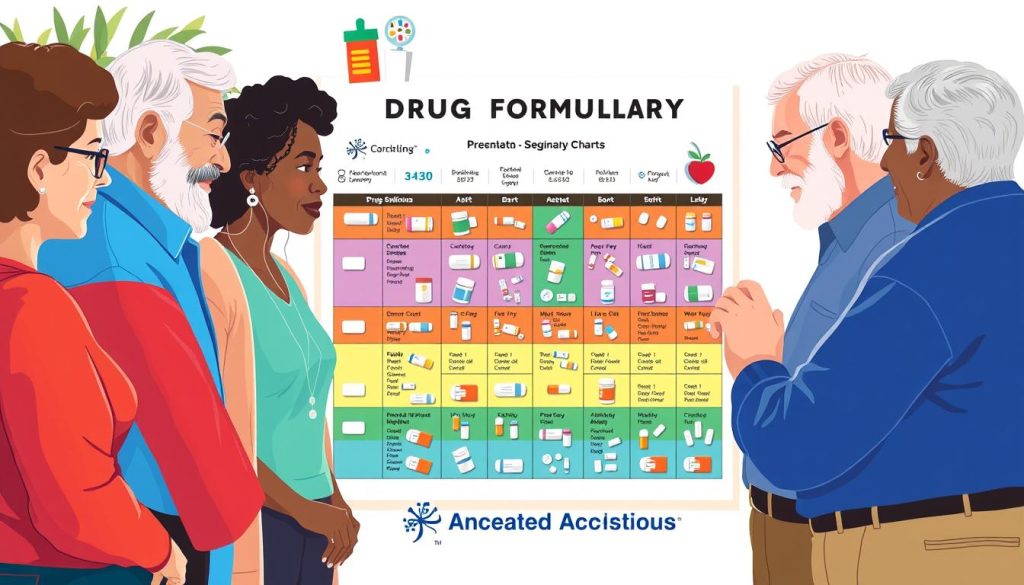Have you ever wondered why knowing your prescription drug plan could save you lots of money each year? Many people don’t pay enough attention to choosing their medication insurance. But, getting it right can help avoid extra costs and worry. This guide makes the tricky parts of Rx coverage clear. It helps you look at different drug benefit plans, figure out what medicines you need, and make smart choices to use your coverage well12.
Key Takeaways
- Understanding prescription drug coverage is crucial for managing medication costs effectively.
- Different plans, such as Medicare Part D, can significantly impact your healthcare expenses.
- Assessing current and future medication needs helps identify the best coverage options.
- The drug formulary outlines which medications are covered and their tier placements.
- Navigating costs, including premiums and copayments, is essential to budget healthcare expenses.
- Accessing copay assistance programs can alleviate financial burdens associated with medications.
Understanding Prescription Drug Coverage
Prescription drug coverage is key in healthcare. It helps people pay for needed medicines. This part of health plans includes a list of drugs and how much they cost. Knowing about this can help patients choose wisely about their medicine insurance.
What is Prescription Drug Coverage?
Prescription drug coverage is part of health insurance that covers medicine costs. These plans put drugs into tiers based on price. For example, Tier 1 has cheaper generic drugs. Higher tiers have costly brand-name drugs. Medicare drug plans use this system to control costs. This helps people know their prescription charges3.
Importance of Having Coverage
Having this coverage is crucial. It gives access to needed medicines, stops money problems, and lets people focus on health. For example, Medicare makes sure patients pay no more than $35 a month for insulin. With many adults needing medicine, this coverage is vital for health management4.
Lacking good coverage, some can’t afford their medications. This leads to missed treatments. Some states help Medicare users with these costs. Knowing your drug plan helps you take care of your health. It ensures you can handle expenses and get necessary medicines3.
Types of Prescription Drug Coverage Plans
Learning about prescription drug plans helps you get medications. We’ll look at important plans. This includes Medicare Part D, Employer plans, and Medicaid Drug plans.
Medicare Part D Plans
Medicare Part D is key for those over 65 or with disabilities. You buy these plans from insurance companies. They differ in costs and the drugs they cover5. Each plan must offer at least two drugs in every category6.
You enroll with the insurance you pick. Each year, you can choose a new plan during a special time5.
Employer or Union Health Plans
Job or union health plans offer drug coverage too. Employers work with PBMs for better drug prices. This makes employee costs lower. These plans can change with yearly negotiations.
Medicaid Prescription Drug Plans
Medicaid helps those with low incomes get medications. You must meet income requirements. States set their own Medicaid rules, including co-pays and drug rules.
| Plan Type | Who It Covers | Key Features |
|---|---|---|
| Medicare Part D | Seniors and disabled individuals | Varies by provider; covers at least 2 drugs per category |
| Employer/Union Plans | Employees and union members | Negotiated pricing; may change annually |
| Medicaid | Low-income individuals | State-specific coverage; prior authorizations required |
Assessing Your Medication Needs
Knowing what meds you need is key for the right drug plan. Checking your current and future med needs helps avoid extra costs. It keeps you healthy.
Identifying Your Current Medications
List your current meds, how much, and how often you take them. This helps compare plans to find the best one. Over 20% of older adults in the U.S. take five or more drugs, showing we need to manage them well8.
Check your meds often to make sure the amounts are still right. Our bodies change how they handle drugs as we get older8.
Evaluating Future Medication Needs
Think about long-term conditions that might need meds later. Doctors check patients a lot across their careers, showing why we must keep evaluating our needs9. Choosing plans with lower costs helps with long-term meds for chronic conditions.
Tools like pill organizers help manage many meds and avoid mistakes8. Ask about cheaper generic drugs at the pharmacy to save money if you can8.
Proper assessment of your medication needs ensures optimal health management and financial efficiency.
Make your med list and look at different plans to find what works for you. Knowing each plan’s details helps make your choice easier.
Looking at your now and future med needs is important. This proactive step helps with costs and keeps you healthy10.
Decoding The Drug Formulary
Getting to know the drug formulary is key if you deal with prescription drug plans. This list shows what meds are covered, breaking them into groups that affect cost. Knowing this list helps you choose wisely and save money on meds.
What is a Drug Formulary?
It’s a big list of meds that insurance plans cover. It tells which meds you can get and how much you pay. For many people, especially those over 65 or with certain disabilities11, it helps make important meds affordable.
Understanding Formulary Tiers
The formulary has tiers, sorting meds by how much you share the cost. Tier 1 has generic drugs, which are cheaper. Tier 2 has brand names with higher costs, and Tier 3 has special meds that cost the most12. Knowing these tiers helps manage your spending.
Identifying Covered Medications
Knowing what meds are covered is crucial to avoid surprises and treatment waits. Your plan decides what drugs are available and how much you pay. Some drugs can be really expensive without coverage11. Programs like CDPHP’s Rx for Less offer big discounts on certain drugs, showing why it’s good to understand your formulary12.

Navigating Costs Associated with Coverage
Understanding prescription drug coverage costs helps manage healthcare money. These costs have insurance premiums, deductibles, and copayments. The average Affordable Care Act (ACA) plan deductible for 2024 is $3,05713. Around 50.5 million people with Medicare have Part D plans in 2023. They deal with these costs13.
Premiums, Deductibles, and Copayments
Insurance premiums are what you pay every month for coverage. Deductibles are what you pay before your coverage starts13. Copayments depend on the drug’s tier. There are four tiers for drugs, based on price and how well they work. Tier 1 has the lowest copayment for generic drugs. Tier 2 has a higher copayment for affordable brand-name drugs14.
Out-of-Pocket Costs Explained
Out-of-pocket costs also include coinsurance and costs for drugs not on your plan’s list. Tier 3 drugs cost the most in copayments. They are brand-name drugs with generic options available. Tier 4 drugs are special ones that need approval first14. Planning for these costs is vital. Americans spend about $1,432.30 each on medications yearly13.
Finding the Right Pharmacy
Finding a good pharmacy is very important for your health. You might want a pharmacy that is easy to get to, saves you money, or one you can trust. Knowing the difference between pharmacies that your insurance covers and mail-order ones is key.
In-Network vs. Out-of-Network Pharmacies
Going to pharmacies that your insurance covers can save you money. These places may charge you less for your medicine. But, pharmacies not covered by your insurance might cost more. This could make you spend more money than you want to.
A study found that many people think highly of their local pharmacist’s knowledge15. Also, very few have had problems with not getting their medicine on time at these pharmacies15.
Mail-Order Pharmacies
Mail-order pharmacies are very handy. They can save you money, especially if you buy your medicine in big amounts at once. For example, Optum Home Delivery Pharmacy offers deals when you buy more16.
Some of these services have insulin and other medicines for $35 or less for a month16. Also, a lot of people say they have trouble finding some medicines in stores. This shows that mail-order might be more reliable for getting your medicine15.
Thinking about pharmacies covered by your insurance and looking into trustworthy mail-order options can really help. You can use tools like the UnitedHealthcare app to find good pharmacies and handle your medicine needs better.
| Type of Pharmacy | Advantages | Disadvantages |
|---|---|---|
| In-Network Pharmacies | Lower costs, quality service, knowledgeable staff | Limited to pharmacy network |
| Out-of-Network Pharmacies | More choices | Higher out-of-pocket costs |
| Mail-Order Pharmacies | Convenience, potential savings on bulk orders | Delivery delays, may lack personal consultation |
Making a smart choice between pharmacies covered by your insurance and mail-order options can improve your health and save you money17.
Utilizing Copay Assistance Programs
It can be tough for lots of Americans to pay for their prescriptions. Copay assistance programs help a lot with these costs. They are put together by drug companies or groups that want to help. These programs make it easier to get the medicines people need, especially if they are very sick.
What is Copay Assistance?
Copay assistance helps people pay for their medicine. Americans spend more than $1,000 each on prescription drugs every year. This can be really hard for people who need lots of medicines. Because of the cost, nearly three out of ten adults skip their medicines. This shows how vital copay assistance is. It lets people get their needed treatments without spending too much.
How to Access Programs
To use these programs, there are a few steps to check if you qualify. You might need to show how much money you make. You could also need papers about your health insurance. Talking to the drug companies or a health helper can make this easier. You can learn more by clicking here. Also, 28% of people have used copay help, proving it works well for lowering medicine costs18.
Lately, more people are dealing with copay maximizers and accumulators. These can make getting help harder19. There is a push for better rules because these challenges can be big. Yet, over 70% of people think copay programs are good. They see how important these programs are in healthcare18.
Applying for Prescription Drug Coverage
When you think about getting coverage for prescription drugs, it’s key to know who can apply. Each plan has rules about things like age, income, and health conditions. Nearly everyone with Medicare, about 90%, can get this helpful coverage20. Knowing these details can help you find the best coverage for you.
Eligibility Requirements
Who can get into a plan can change, especially with Medicare. If you’re close to 65, you have a 7-month period to sign up for Medicare Part D21. If you wait too long, you might have to pay extra, as about 36% of people do20. It’s really important to know when you can apply to avoid extra fees.
Application Processes for Various Plans
Applying for drug coverage changes depending on the plan. For Medicare, there are specific times to enroll, like from October 15 to December 7 each year21. You should talk to a few plans to get details on costs since they can vary a lot20. Also, if you already have insurance through work or a union, see how it fits with new coverage20.

Managing Your Coverage Over Time
Checking your prescription drug coverage often is key, especially when things change. Doing a yearly plan review helps. It makes sure your coverage matches your current needs. You can spot any coverage gaps or better options.
Annual Review of Your Plan
Doing a yearly plan check is a good chance to look over your meds. It’s normal for your meds to change during the year. A yearly review helps see if your coverage is still right. It’s important to keep an eye on health changes. This ensures you’re getting the most from your benefits while managing your coverage well.
Making Changes to Your Coverage
Big life events might mean you need to adjust your coverage. Knowing how to handle these changes is important for your care. If you have Medicare Part D and TRICARE for Life, Medicare pays first. TRICARE covers the rest22. If changes are needed, the TRICARE Formulary Search Tool can help make the process easier.
| Aspect | Details |
|---|---|
| Annual Plan Review | Essential for assessing whether your current plan aligns with your health needs. |
| Coverage Changes | Necessary during life transitions such as new prescriptions or financial adjustments. |
| Resources Available | TRICARE Formulary Search Tool, Express Scripts online account, and mobile app. |
Focusing on reviews and knowing your resources can really help. You can manage your prescription coverage much better222324..
Conclusion
It’s important to understand your prescription drug coverage. This helps you get the medicines you need without spending too much. There are many plans like Medicare Part D or employer health plans. Each one has different benefits. In 2001, a survey showed that not all seniors have good drug coverage. Some states only have 20% coverage while others have 38%. This shows how hard it can be to find good help for health needs25.
The cost of healthcare is rising fast. From 2012 to 2016, spending on prescriptions went from $250.7 billion to $341.0 billion26. This means it’s key to plan your budget and look into all the help you can find. Things like copay assistance programs and checking your coverage every year are smart moves.
Now, more people are using specialty drugs. This means we need better rules to help seniors with low income25. Being smart about your coverage options can make your health care better. It can also make sure you’re not worried about costs in the future. Learning more and using the right resources is the best way to manage your prescriptions.
Source Links
- Medicare Part D Manual
- How to enroll in prescription drug coverage – Medicare Interactive
- TIPS FOR UNDERSTANDING YOUR DRUG COVERAGE & PRESCRIPTIONS
- An Overview of Prescription Drug Insurance
- What is a PDP (Prescription Drug Plan)?
- What Medicare Part D drug plans cover
- Medicare Prescription Drug Plans
- Medication Management and Safety Tips
- Chapter 6. The Assessment
- What should I look for in a Medicare Prescription Drug Plan?
- Unveiling Prescription Drug Coverage: The Medicare Connection | Decent
- Decoding your Rx Benefits
- Prescription Drug Insurance Plans: Coverage & Costs | eHealth
- Understanding Drug Tiers – Patient Advocate Foundation
- Finding the Right Pharmacy – Consumer Reports Magazine
- Shop Medicare prescription drug plans
- Pharmacy and prescription drugs
- Patient perspectives and use of copayment assistance during the COVID-19 pandemic
- Copay Adjustment Programs: What Are They and What Do They Mean for Consumers? | KFF
- How to get prescription drug coverage
- How to enroll in a Medicare Part D prescription drug plan
- Understanding Medicare Part D and TRICARE Pharmacy Coverage
- A Current Snapshot of the Medicare Part D Prescription Drug Benefit | KFF
- Prescription Drug Coverage and Effects on Drug Expenditures among Elderly Medicare Beneficiaries
- Prescription drug coverage and seniors: how well are states closing the gap? – PubMed
- The Prescription Drug Landscape, Explored

Leave a Reply